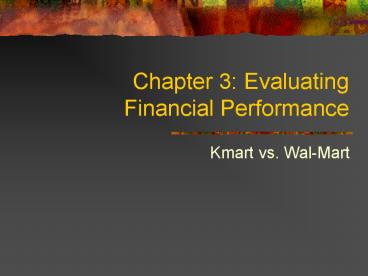Chapter 3: Evaluating Financial Performance - PowerPoint PPT Presentation
1 / 22
Title:
Chapter 3: Evaluating Financial Performance
Description:
Kmart vs. Wal-Mart. Objectives ... Kmart and Wal-Mart's Liquidity Ratios ... Kmart & Wal-Mart's Return on Equity. DuPont Analysis of Return on Common Equity (ROE) ... – PowerPoint PPT presentation
Number of Views:1290
Avg rating:3.0/5.0
Title: Chapter 3: Evaluating Financial Performance
1
Chapter 3 Evaluating Financial Performance
- Kmart vs. Wal-Mart
2
Objectives
- Calculate financial ratios to evaluate the
financial health of a company. - Apply DuPont analysis in evaluating a firms
financial performance. - Explain the limitations of ratio analysis.
3
Relevant Principles
- Principle 7 Agency relationships, managers wont
work for the owners unless its in their best
interest to do so. - Principle 5 Competitive markets make it hard to
find exceptionally profitable investments. - Principle 1 The risk-return trade-off we wont
take more risk unless we expect higher returns.
4
How to use Financial Ratios?
- Compare across time for an individual firm. Trend
Analysis. - Compare to an industry average. Industry
Analysis. - Compare to a dominant competitor in the same
industry. Comparison Analysis. - We will conduct trend analysis for both Kmart
Wal-Mart and compare the ratios of the two
companies.
5
4 Key Questions to Answer with Ratio Analysis
- How liquid is the firm?
- Is management generating adequate operating
profits on the firms assets? - How is the firm financing its assets?
- Are the stockholders receiving an adequate return
on their investment?
6
How liquid is the firm?
- Measuring Liquidity Approach 1 comparing liquid
assets to short-term debt. - Current Ratio Current Assets/Current
Liabilities - Acid-test Ratio (Current Assets
Inventory)/Current Liabilities
7
How liquid is the firm?
- Measuring Liquidity Approach 2 How easily can
other current assets be converted into cash. - Average Collection Period Accounts
Receivable/Daily (Credit) Sales - Accounts Receivable/(Sales/365)
- Accounts Receivable Turnover (Credit)
Sales/Accounts Receivable - Inventory Turnover Cost of Goods Sold/Inventory
8
Kmart and Wal-Marts Liquidity Ratios
9
Is management generating adequate operating
profits on the firms assets?
- Operating Return on Investment (OIROI)
- Operating Income/Total Assets, also
- Operating Profit Margin x Total Asset Turnover
- Operating Profit Margin Operating Income/Sales
- Operating Income Pre-Tax Income plus interest
expense, or Pre-tax income minus interest, non-op - Total Asset Turnover Sales/Total Assets
- Affected by Accounts Receivable Turnover,
Inventory Turnover, Fixed Asset Turnover - Fixed Asset Turnover Sales/Net Fixed Assets
Net Fixed Assets Property, Plant, Equip, NET
10
Kmart Wal-Marts Operating Profitability Ratios
11
How is the firm financing its assets?
- Debt Ratio Total Liabilities/Total Assets
- Times-Interest-Earned Operating Income/Interest
Expense - Operating Income Pre-Tax Income plus interest
expense, or Pre-tax income minus interest, non-op
(int exp for Kmart)
12
Kmart Wal-Marts Financing Ratios
13
Are the stockholders receiving an adequate return
on their investment?
- Return On Common Equity
- Net Income Available to Common Stockholders(includ
ing EIDO)/Total Common Equity - Total Common Equity Total Shareholders Equity
Preferred Stock
14
Kmart Wal-Marts Return on Equity
15
DuPont Analysis of Return on Common Equity (ROE)
- Breaks down company performance into operational
and financing components. - ROE (Net Profit Margin x Total Asset
Turnover)/(1-Debt Ratio), where - Net Profit Margin Net Income(available to
common stockholders including EIDO)/Sales - Total Asset Turnover Sales/Total Assets
- Debt Ratio Total Liabilities/Total Assets
- Net Profit Margin x Total Asset Turnover Return
on Assets, which are the operating components. - 1/(1-Debt Ratio) measures impact of financial
leverage
16
How does Leverage work?
- Suppose we have an all equity-financed firm worth
100,000. Its earnings this year total 15,000. - ROE
- (ignore taxes for this example)
17
How does Leverage work?
- Suppose we have an all equity-financed firm worth
100,000. Its earnings this year total 15,000. - ROE 15
15,000 100,000
18
How does Leverage work?
- Suppose the same 100,000 firm is financed with
half equity, and half 8 debt (bonds). Earnings
are still 15,000. - ROE
19
How does Leverage work?
- Suppose the same 100,000 firm is financed with
half equity, and half 8 debt (bonds). Earnings
are still 15,000. - ROE
15,000 - 4,000 50,000
20
How does Leverage work?
- Suppose the same 100,000 firm is financed with
half equity, and half 8 debt (bonds). Earnings
are still 15,000. - ROE 22
15,000 - 4,000 50,000
21
Kmart Wal-Marts DuPont Analysis
22
Caveats of Ratio Analysis
- Different Accounting Practices.
- Sometimes hard to pick an industry for
comparison. - Seasonality in Operations.































